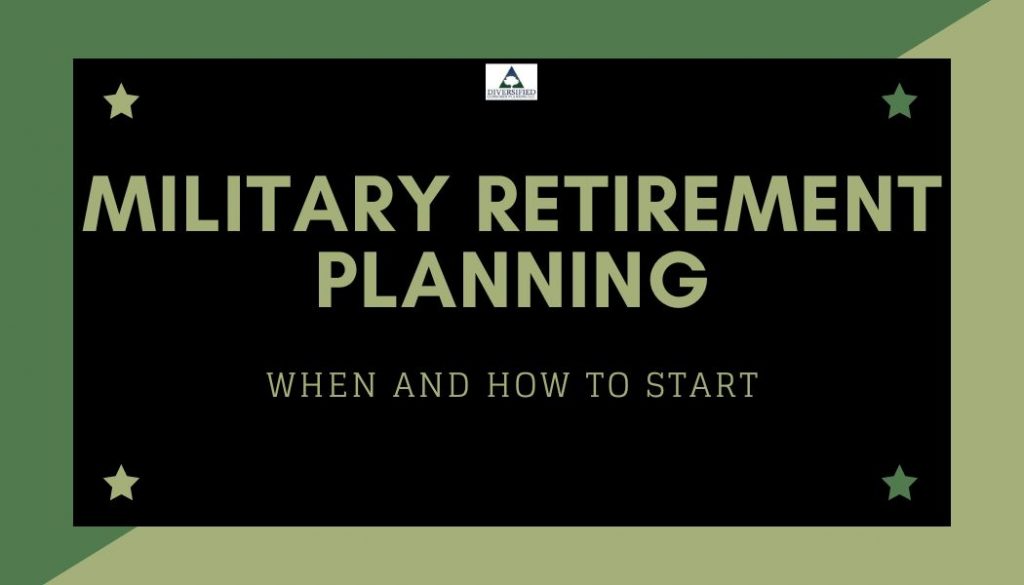As a military service member, you need specialized military retirement planning. It is important to understand when to start planning for retirement and how you can secure your future.
When Should You Start Planning for Military Retirement?
All transitioning service members are required to begin the official transition process, including TAP counseling, no later than 365 days prior to separation or retirement.
It is recommended to start planning for transition 36 months before the separation date.
Pre-separation counseling must start no later than 365 days prior to transition. You can avail Transition Assistance Program and other programs to prepare for the life ahead.
When it comes to military retirement planning, the earlier you start, the more prepared and secure your transition will be.
10 Years Before Retirement
If you are a junior officer or NCO with a decade to retirement, review your service records and pay history. Also take your promotions into account as this affects your final pay and other benefits.
| If you’re under the Blended Retirement System (BRS), contribute at least 5% of your basic pay to receive the full government match. |
5 Years Out
- If you opted into BRS in 2018, or joined after Jan 1, 2018, you are already enrolled in BRS. Earlier entrants may still be under the legacy High-3 system.
- Decide whether it’s better to pay taxes now with Roth, later with Traditional, or use a mix of both.
- Make sure your beneficiaries are up to date.
- Consider using the GI Bill or military training programs to pursue further education or certification.
Final Year
With one year to go, start focusing on the execution.
- Most military branches require you to start retirement seminars at least 12 months before you retire.
- Submit your retirement request. In 2023, the army started a pilot program allowing soldiers to request retirement 24 months before their retirement date.
- Complete all necessary paperwork, including: TSP distribution choices, Survivor Benefit Plan (SBP) elections, VA disability claims, and TRICARE enrollment or updates.
- Review and finalize your health insurance plan for post-retirement coverage.
- Set aside funds to cover temporary income or healthcare gaps.
Key Components of Military Retirement Planning
Thrift Savings Plan (TSP)
The federal government offers federal employees and members of the uniformed services a retirement savings and investment plan known as The Thrift Savings Plan (TSP).
- Under the Blended Retirement System (BRS), the federal government adds 1% of your base pay to your TSP every payday. If you contribute 5%, the government matches up to 4%.
- You can lower taxable income now with traditional contributions but withdrawals in retirement will be taxed.
- Roth contributions are taxed now, but your money grows tax-free, and qualified withdrawals in retirement are not taxed.
- The Department of Defense calculates its match based on your contribution to both Roth and Traditional. Your traditional TSP receives all the matching funds (even if you contribute to Roth).
Once you retire, you can roll your TSP to an IRA or civilian retirement plan. Or you can leave it invested.
| Important: The Defense Finance and Accounting Service cannot continue loan allotments after separation. You must either repay your TSP loan or face potential tax consequences for any unpaid balance. The loan becomes a taxable distribution if not repaid within the IRS timeframe after separation. |
Military Pension
Retiring after 20 years service qualifies you for guaranteed monthly retirement pay based on your service. The amount you receive depends on one of the following systems:
- Legacy high-3 system
- Blended Retirement System
| Retirement System | Who It Applies To | Pension Formula | Long-Term Growth |
| Legacy High‑3 System | Entered before Jan 1, 2018 or didn’t opt into BRS | 2.5% × Years of Service × Average of Highest 36 Months of Base Pay | Increases by 2.5% for each additional year of service |
| Blended Retirement System (BRS) | Joined on or after January 1, 2018, or chose to switch to BRS during the opt-in period. | 2.0% × Years of Service × Highest 36 Months of Base Pay | Increases by 2.0% for each additional year of service |
Blended Retirement System (BRS) Specifics
If you joined the military on or after January 1, 2018, or opted in to the Blended Retirement System (BRS) during the 2018 opt-in window, your retirement consists of a smaller pension combined with Thrift Savings contributions.
The Blended Retirement System provides you with the following two benefits:
A pension
2% of basic pay for each year of service
Thrift Savings Plan (TSP)
- Automatic contribution of 1% of your basic pay by the federal government.
- The government matches up to 4% if you contribute 5% of your own basic pay.
Planning for Your Children’s Education
If part of your retirement strategy includes helping your children or grandchildren with college costs, consider using a tax-advantaged savings tool like a 529 Plan. It allows your investments to grow tax-free when used for qualified education expenses—and fits seamlessly into a long-term military financial plan.
Healthcare
You and your family still qualify for TRICARE health coverage when you retire from the military. However, you may have to start paying enrollment fees and copays. Understanding your options is essential for budgeting and avoiding surprises.
TRICARE Prime
This option comes with lower out-of-pocket costs. However, you have a limited network of providers to choose from and typically need referrals to see specialists.
TRICARE Select
You get more options to choose from but out-of-pocket costs are higher.
- About $4,261 per family for Group A retirees (joined before 2018)
- Up to $4,509 per family for Group B retirees (joined in 2018 or later)
TRICARE For Life (Post-65 Coverage)
You automatically become eligible for TRICARE For Life (TFL) when you turn 65 and have Medicare Part A and Part B. TRICARE For Life is a secondary payer to Medicare, not a replacement. Medicare pays first and the remaining approved costs are covered by TRICARE. There is no additional enrollment fee for TRICARE For Life.
VA Health Care
If you have service-connected disabilities, you may qualify for VA Health Care. You are eligible when you have:
- Served on active duty
- Received an honorable discharge
- Met minimum length-of-service requirements
You can reduce your out-of-pocket healthcare expenses by using TRICARE and VA benefits together.
What TRICARE Doesn’t Cover
TRICARE generally doesn’t cover services or supplies unless they’re medically or mentally necessary for treating an illness, injury, pregnancy, or well-child care.
Don’t forget to check exclusions in TRICARE.
Life Insurance
Your Servicemembers’ Group Life Insurance (SGLI) coverage ends when you retire from active duty. So, plan ahead for continued life insurance.
SGLI to VGLI Conversion
You can convert Servicemembers’ Group Life Insurance (SGLI) to Veterans’ Group Life Insurance (VGLI), allowing you to obtain term life coverage of up to $500,000, equal to your SGLI amount.
|
VGLI premiums increase as you age, making it more expensive over time. This is why many retirees consider civilian life insurance policies and other alternatives. So it’s best to explore your options well before the one-year VGLI deadline.
Survivor Benefit Plan (SBP)
Survivor Benefit Plan (SBP) provides continuing income to the designated beneficiary after your death. This government-sponsored annuity works like a lifelong insurance policy and pays 55% of your chosen “base amount” of retired pay each month.
How Do SBP Premiums Work
If you elect coverage for your spouse only then premiums will cost you about 6–7% of your covered base pay. This amount is automatically deducted from your gross retired pay. This deduction is from pre-tax income.
Government Backing and Inflation Protection
Backed by the federal government, SBP is adjusted for inflation through annual Cost-of-Living Adjustments (COLA). It’s a stable guaranteed income for your surviving spouse. It’s a cost-effective alternative to private insurance.
| Important: If you do not make an SBP election before retirement, you will automatically receive full spouse coverage based on your full retired pay. However, you can make a different election before retirement if desired. There are some exceptions. |
SBP or Private Insurance?
Many military retirement planning experts consider SBP to be an advantageous financial choice for retirees who want to provide long-term income to their spouse or children. Still, compare SBP cost and benefits with other options. Get advice from a military retirement planning advisor.
Tax Planning
Military retirement benefits change your tax picture.
VA Benefits
The federal government does not tax VA disability compensation and GI Bill education benefits.
Military Retirement Pay and SBP
Your military retired pay is fully taxable. SBP payments received by beneficiaries are taxable as ordinary income.
State Income Tax Rules
Some states fully exclude your military retirement pay from income tax. Other states partially or fully tax military retirement pay.
Planning for the Transition to Civilian Life
Estimating the Income Gap
You will need savings or a job to budget for rent/mortgage, food and other civilian expenses. Calculate and compare your likely pension to your current salary. You may need TSP withdrawals, investments, part-time work, or a new career to cover this gap.
Building a Career Plan
Start evaluating civilian roles that suit your background and goals.
GI Bill and Tuition Assistance
You may be eligible for up to 36 months of Post-9/11 GI Bill benefits. If you used other VA education benefits, the combined maximum is typically 48 months. You can use these benefits for college degree, vocational training or certification.
From Military Experience to Civilian Roles
Research certifications that align with your military experience such as commercial driving, medical fields or information technology.
Transition Assistance Program
The U.S. Department of Defense offers a Transition Assistance Program to prepare for transition from military to civilian life. This program includes workshops and training sessions on career, resume writing, interview and financial planning.
Prepare for Entrepreneurship
If you want to work independently or start your own business, then research the required education, licensing and regulatory requirements.
Start early so that you will be job-ready by the time you leave the military.
Rollover Options – TSP and IRAs
TSP contributions automatically stop when you leave active duty unless you enter federal civilian service and resume contributions. Now you have two options:
- You can keep your funds in your TSP account and let them grow.
- Or, you can roll over the funds to a traditional IRA, a Roth IRA or a qualified retirement plan with a civilian employer
Keep in mind that Roth rollovers can have tax implications.
If you plan to work in federal civil service then you can combine TSP accounts later.
Taxes After Separation
You will file taxes as a retiree after separation. You can access several free tax preparation options including:
- IRS Free File (If your adjusted gross income (AGI) is $84,000 or less)
- IRS Direct File (if your state participates in the program)
- Mil Tax (through Military OneSource) offers free tax software and support for up to one year after separation, with possible extensions for those using TAP.
Common Mistakes to Avoid
Waiting Too Long
If you wait till the last minute, you will miss some paperwork, key benefits, or education and training opportunities. Delayed paperwork can affect your retirement pay, healthcare, and job prospects.
Confusing BRS vs. Legacy Rules
Don’t get confused with the two retirement systems. BRS and legacy rules are different systems with different pension formulas and TSP matching rules. You may miscalculate your retirement income if you use the wrong rules.
Misunderstanding SBP and Pension Taxation
Some retirees assume that SBP is tax free. However, SBP annuities are taxable income to survivors. VA disability pay is tax-free.
Underestimating Healthcare Costs
TRICARE is not free for life. Don’t forget to budget for new fees and copays. Be sure to review the 2025 TRICARE fee schedule to estimate your future healthcare costs.
| Pro Tip: One of the most important decisions you can make during retirement planning is choosing the right advisor. A fee-only financial advisor acts in your best interest without earning commissions on products they recommend—ensuring transparent, objective advice tailored to your military retirement needs. |
How Diversified Consumer Planning helps Submariners and veterans
The answer to how to plan for military retirement is complex. Let’s be honest, you cannot do it without a military-focused financial planner.
We have in-depth knowledge of military pay, allowances, benefits and taxes. We can help you navigate the complex mix of retirement systems, healthcare options, survivor benefits, and tax rules to help you build a customized plan.
Financial planning services for veterans is different from civilian planning. Start building your retirement roadmap today!
==============================================================
References:
https://www.dodtap.mil/dodtap/app/transition/pre-separation_counseling
https://www.navymutual.org/mutually-speaking/general/blended-retirement-system-vs-legacy-high-3/
https://tricare.mil/CoveredServices/IsItCovered/Exclusions
https://www.military.com/benefits/military-pay/state-retirement-income-tax.html
https://www.dfas.mil/RetiredMilitary/provide/sbp/change/
https://www.irs.gov/filing/irs-free-file-do-your-taxes-for-free






